By Team ICON Meals Shawn Wells. Follow Shawn on Instagram
I’m incredibly humbled to be known as “The World’s Greatest Formulator,” and it’s an honor that I don’t take lightly. Now, I wouldn’t have gotten into supplements, become so passionate about formulating, and been tagged with that nickname if I didn’t strongly—very, very strongly—believe that supplements could be tremendously helpful to virtually everyone.
As you can imagine, one of the most common questions that I get goes a little something like this: “Shawn, what are your top supplements?” Basically, people want to know what supplements I use personally, and of course, they want my insight into what supplements I think may be best for them to take.
Obviously, a supplement regimen should be personalized based on an individual’s needs and goals, and so it would be virtually impossible to provide a list that unequivocally applies to everyone. Having said that, here are my top 10 supplements, which I use myself and most often recommend to others.
Creatine
Creatine is perhaps the most popular and extensively studied sports nutrition supplements of all time. According to the International Society of Sports Nutrition position stand, “Studies have consistently shown that creatine supplementation increases intramuscular creatine concentrations, can improve exercise performance, and/or improve training adaptations.”
In other words, research clearly, consistently, and convincingly shows that supplementation with creatine increases strength, hypertrophy, power, and athletic performance. Even more, creatine supplementation may enhance recovery from exercise, injury prevention, thermoregulation, rehabilitation, and traumatic brain injury (i.e., concussions).
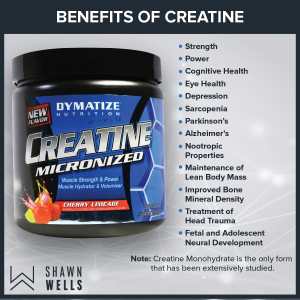 But the application of creatine extends beyond those better-known benefits. For example, emerging evidence suggests creatine supplementation may have clinical applications in a variety of neurodegenerative conditions (including muscular dystrophy, Parkinson’s, Huntington’s), diabetes, osteoarthritis, fibromyalgia, aging, brain and heart ischemia, depression, and pregnancy.1
But the application of creatine extends beyond those better-known benefits. For example, emerging evidence suggests creatine supplementation may have clinical applications in a variety of neurodegenerative conditions (including muscular dystrophy, Parkinson’s, Huntington’s), diabetes, osteoarthritis, fibromyalgia, aging, brain and heart ischemia, depression, and pregnancy.1
I recommend using creatine monohydrate (such as Creapure®) and taking 3 – 10 grams per day. It doesn’t matter if you do it in divided doses, so whatever is best for you with compliance.
Alpha-GPC
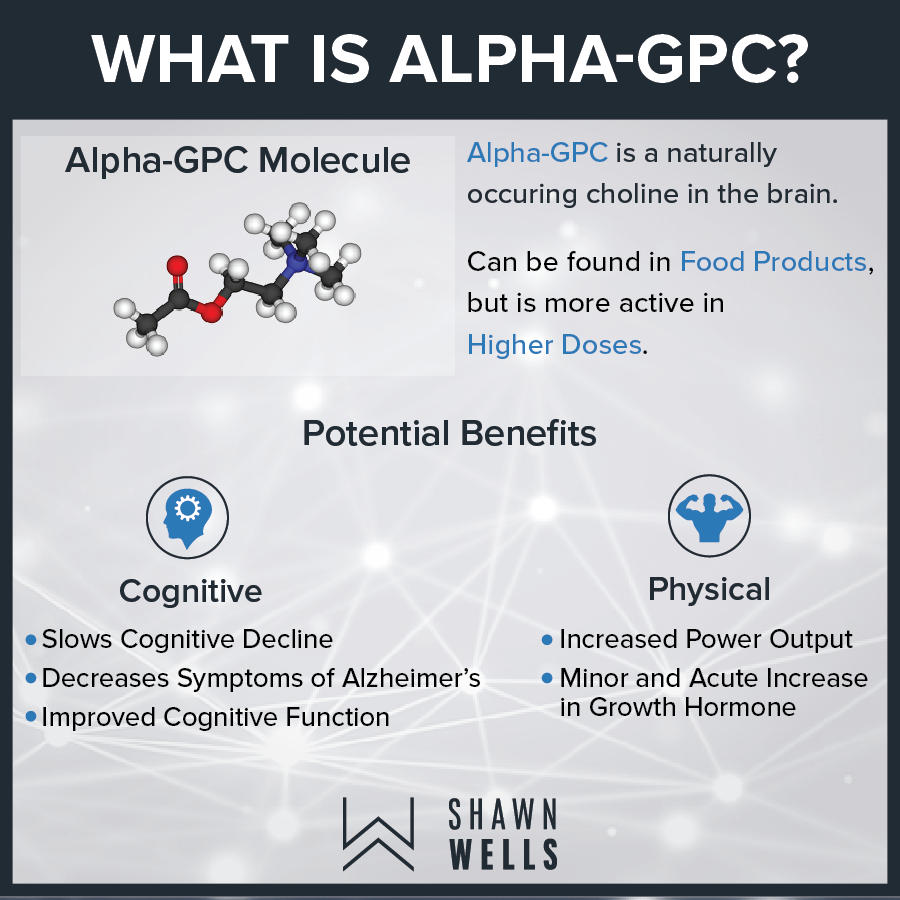
Alpha-GPC is a naturally-occurring choline, which refers to a class of molecules that are used for various functions in the brain. For instance, choline is the main building block for the neurotransmitter acetylcholine, which performs several critical functions including facilitating communication in areas of the brain associated with memory and concentration and triggering muscle contraction.
Along those lines, supplementation with Alpha-GPC offer several potential mental and physical benefits including improved cognitive function, attenuated cognitive decline, increased power output, and increased growth hormone production. In one randomized controlled trial, Alzheimer’s patients supplementing with Alpha-GPC (400mg @ 3 times/day) for 180 days experienced significant improvements in cognitive function.2
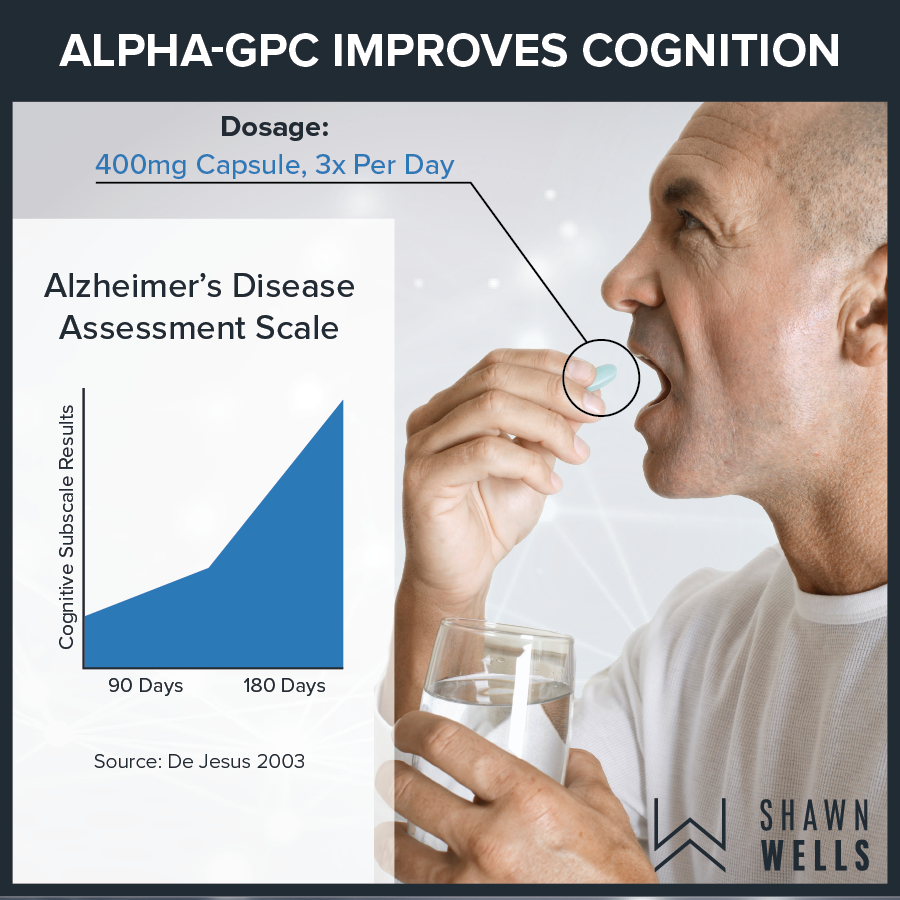
From an athletic performance standpoint, one randomized controlled trial found that supplementation with 600mg per day of Alpha-GPC for 6 days significantly increased lower body force production. The researchers concluded, “Sport performance coaches can consider adding A-GPC to the diet of speed and power athletes to enhance muscle performance.”3
I prefer the branded form, Alpha-Size, by Chemi-Nutra.
TeaCrine®
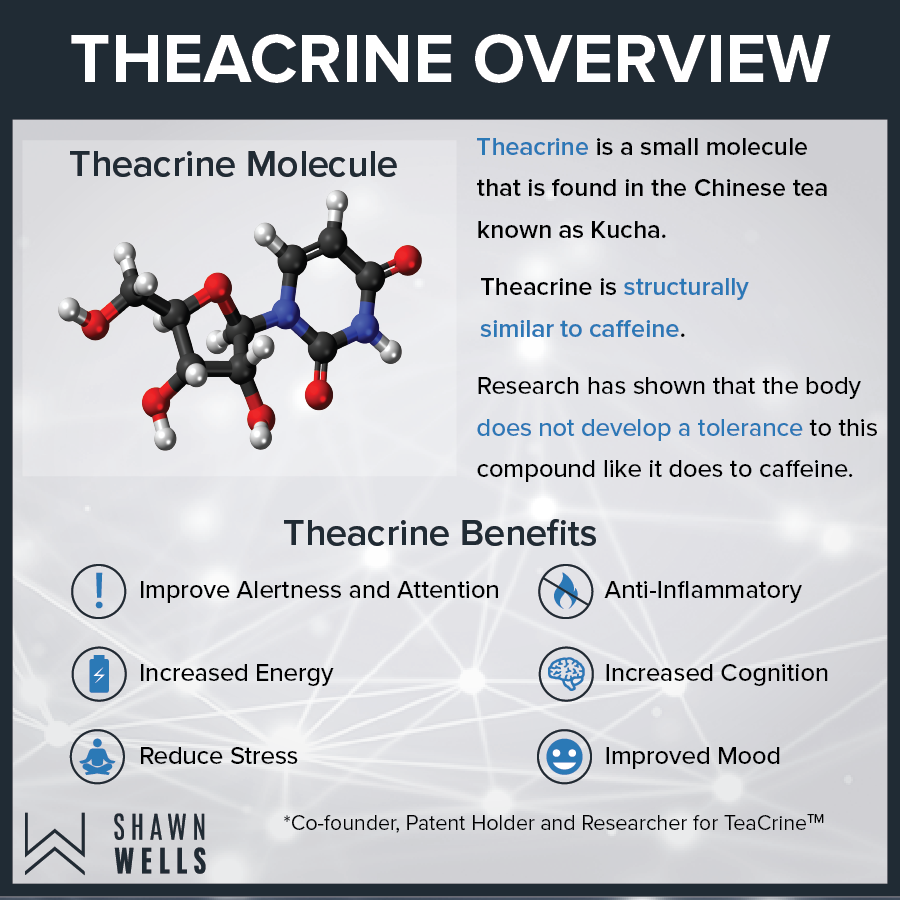
Theacrine is structurally similar to caffeine but is longer lasting, and research has shown that supplementation with theacrine increases energy, focus, concentration, willingness to exercise, and motivation to train while reducing fatigue—all without any increase in heart rate.4 Also unlike caffeine, theacrine, which possesses antioxidant and anti-inflammatory properties, has been shown to provide these neuro-energetic effects while also being non-habituating.5
Research has also demonstrated synergy when theacrine is consumed with caffeine, and the combination has been shown to improve feelings of wellbeing, attention, alertness, focus, and energy levels while reducing feelings of lethargy and grogginess when compared to placebo or caffeine alone.6
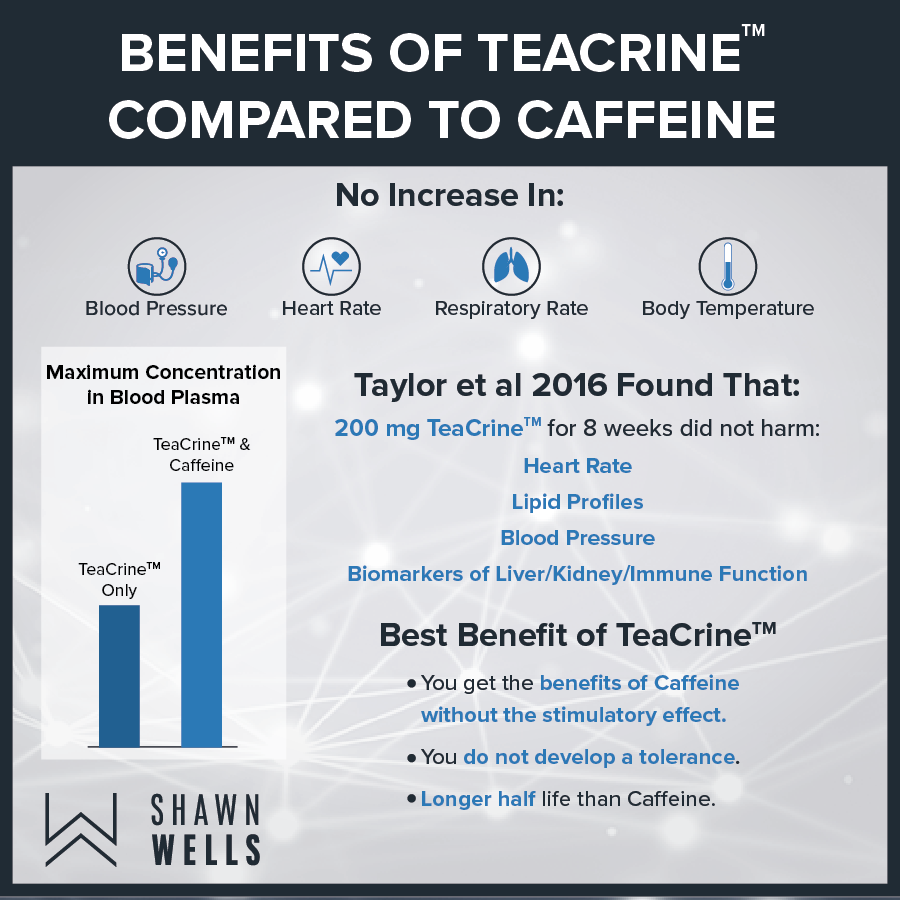
TeaCrine® is a branded, patented, research-backed form of theacrine that I use myself and recommend to others. I recommend taking 200mg per dose, but doses up to 400mg have been shown to be safe. If taking with caffeine 125mg is effective.
Curcumin
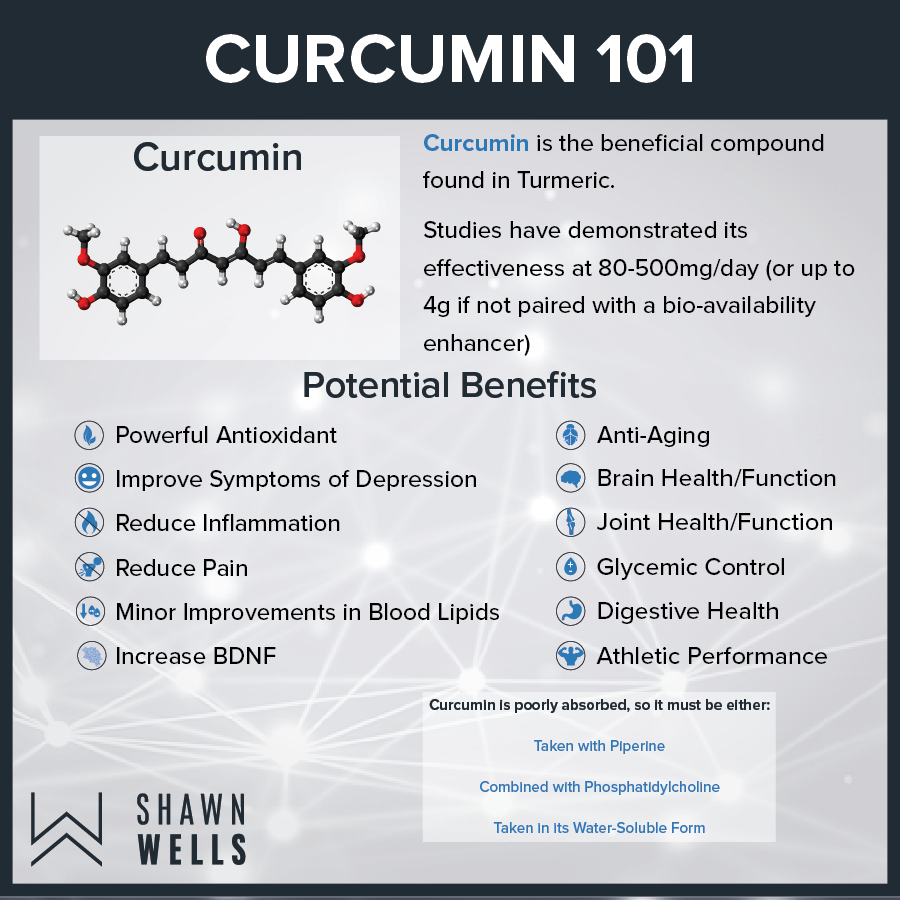
Turmeric is one of the hottest spices and dietary supplements, and for good reason. Turmeric, which belongs to the ginger family, has a long history of use in the Indian system of holistic medicine known as Ayurveda. While there is a laundry list of health benefits associated with turmeric, many of them seem to trace back to its curcuminoids, notably curcumin, a powerful antioxidant polyphenol that gives turmeric its yellow pigment.
With over 3,000 preclinical investigations, curcumin is one of the best studied botanical constituents in the biomedical literature.7 These studies have revealed that curcumin has antioxidant, antibacterial, antifungal, antiviral, and anti-inflammatory effects.8 Not surprisingly, studies have shown that curcumin may have beneficial effects on inflammation, cancer, joint health, blood sugar management, infections, osteoarthritis, Alzheimer’s, Parkinson’s, Multiple Sclerosis, mitochondrial function, athletic performance, and more.
It’s worth noting that the potential health benefits of turmeric and curcumin are limited by poor solubility, low absorption from the gut, rapid metabolism, and rapid elimination.9 With that in mind, when supplementing with curcumin, taking a water-soluble form, a liposomal form, or combining it with black pepper may improve absorption. Assuming one of these bioavailability-enhanced versions of curcumin is used, then I recommend a dose between 200 – 250mg of curcuminoids per day.
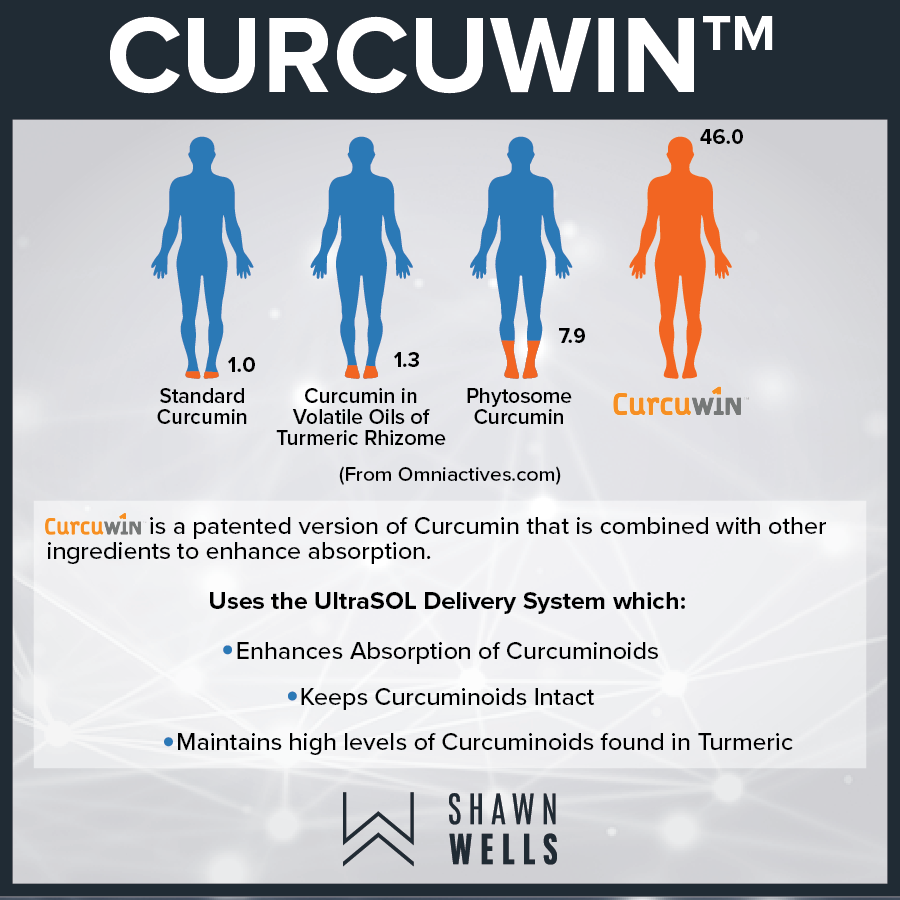
My favorite form is CurcuWin by OmniActives as it has 46x the bioavailability and is EDC-free. EDC is a toxic solvent that is carcinogenic that’s found in many curcumin products in the industry.
Berberine
Berberine is main bioactive alkaloid found in multiple Chinese medicinal herbs, including Coptidis Rhizoma, Cortex Phellodendri, Hydratis Canadensis (also known as goldenseal), and Coptis Chinensis. Berberine has been used for thousands of years in Chinese medicine to treat gastrointestinal infections and diabetes.
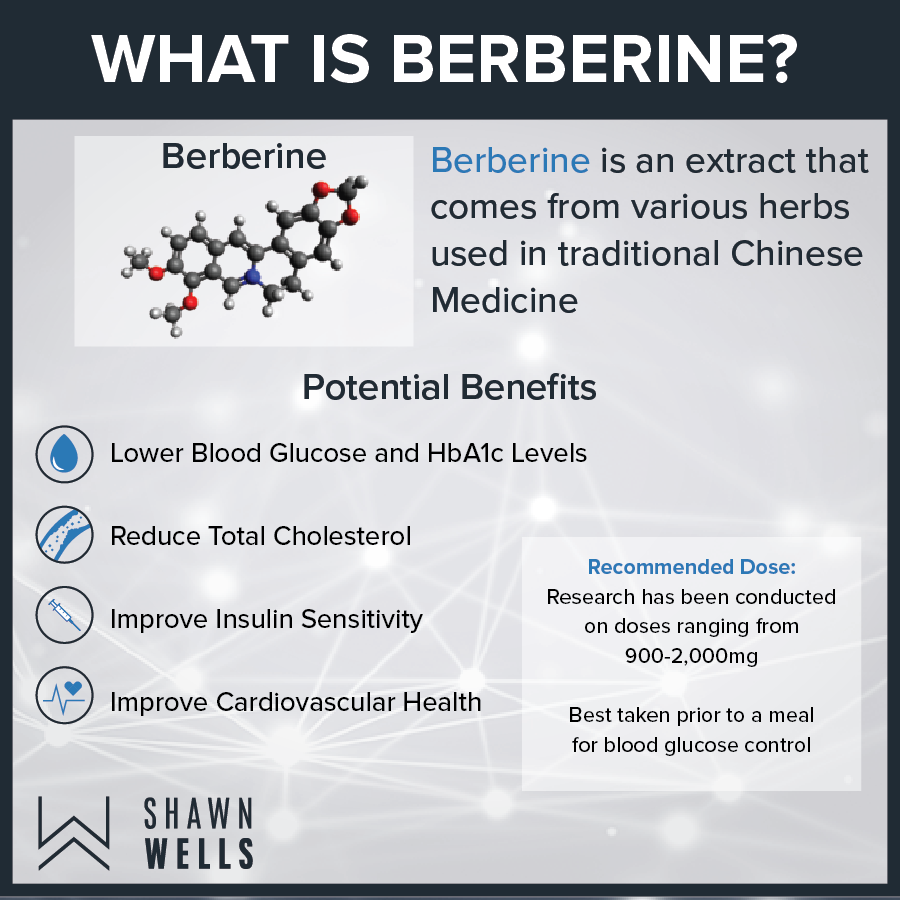
Along these lines, Berberine is well-known as a potent insulin sensitizer, which has been validated in multiple randomized controlled trials. In fact, it has been shown to be equally effective at reducing insulin resistance as the popular diabetic drug Metformin—that’s powerful!10,11 To me, this alone is more than enough reason to make my top 10 list, especially considering that blood sugar management, insulin sensitivity, and metabolic function touch virtually every corner of human health and optimization.
But there’s more. Berberine has been shown to activate AMP-activated protein kinase (AMPK), which is responsible for a variety of crucial functions in the body. For example, AMPK, which is known as an “energy sensor,” is thought to be responsible for multiple health benefits assigned to exercise and caloric restriction.12 Speaking of which, AMPK possesses anti-aging properties via activation of mitochondrial biogenesis. In addition, Berberine has powerful antioxidant, anti-inflammatory, and antimicrobial properties.
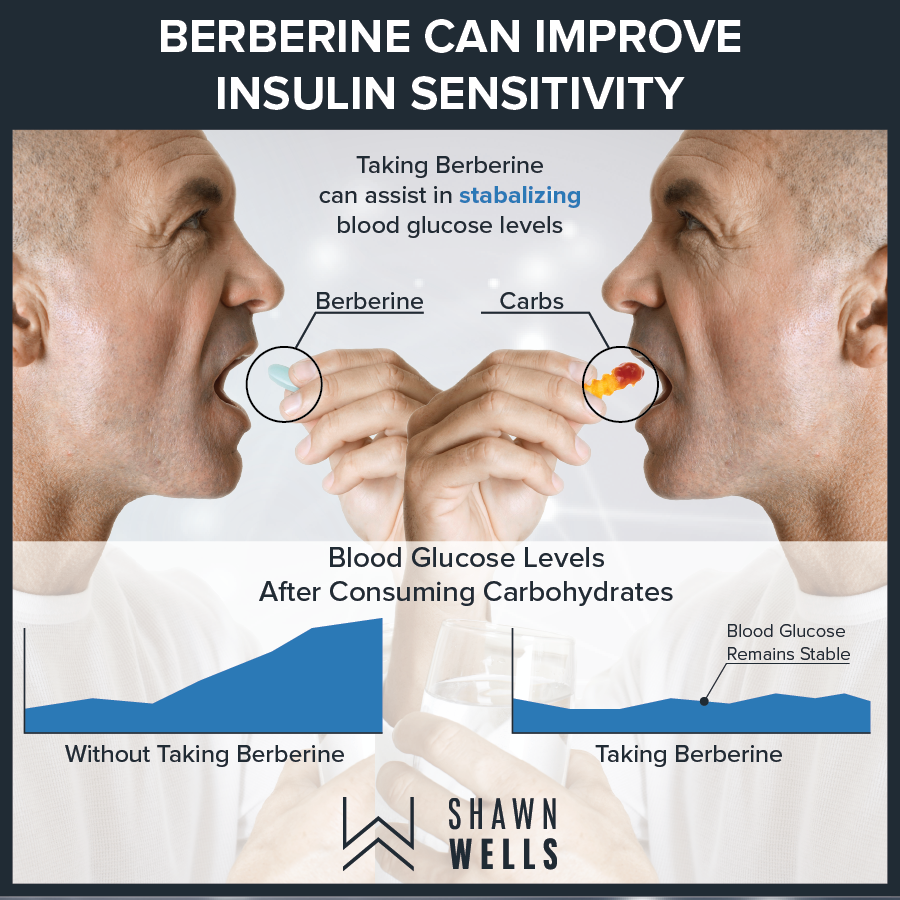
I recommend taking 500mg of Berberine three times daily. Only buy this from a reputable company, many of the berberine products are spiked with other plants and not nearly as effective.
Ashwagandha
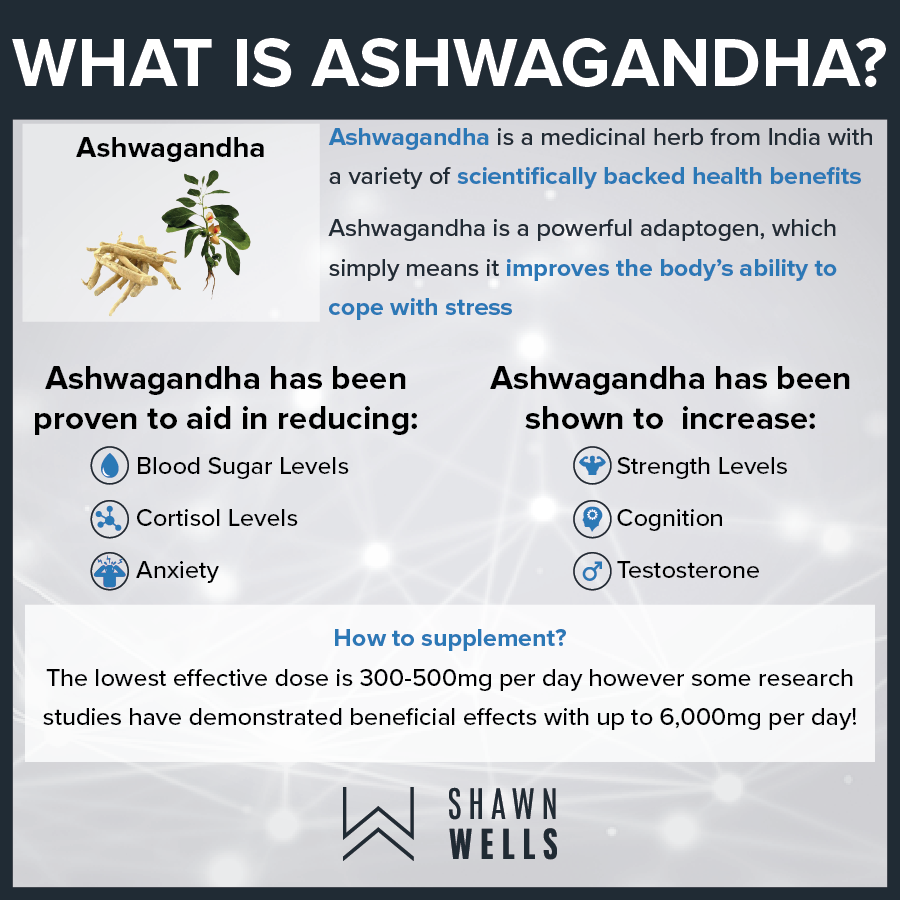
Also known as Withania somnifera, Ashwagandha is an evergreen shrub found in the arid parts of India. Ashwagandha literally means “smell of horse,” which is part because it’s commonly believed that it can help develop strength and vitality similar to that of a horse.13 Referred to as a “royal herb” because of its well-known rejuvenating effects, Ashwagandha is an “adaptogen” that’s highly regarded for its ability promote health and longevity, slow the aging process, revitalize the body, combat stress, and improve feelings of well-being.
For me, some of the most interesting benefits are Ashwagandha’s capacity to improve energy levels and mitochondrial health.14 On one hand, Ashwagandha can have beneficial effects on mitochondrial functioning; what’s more, Ashwagandha can reduce the activity of the enzyme responsible for breaking down ATP (i.e., increasing cellular energy levels).15 Case in point, one of the primary components of muscle development and exercise performance is energy production. Along these lines, when combined with resistance training, Ashwagandha has been to increase muscle size and strength and boost endurance.15
In addition, Ashwagandha is perhaps best known for its ability to increase resilience, reduce stress, and decrease cortisol.13,16 Along those lines, there is an interesting link between chronic stress (e.g., psychosocial stress, stressful life experiences) and mitochondrial dysfunction. Specifically, chronic stress can generate toxic by-products, promote systemic inflammation, and alter gene expression, ultimately damaging mitochondria and accelerating cellular aging.17
I’d recommend looking for an Ashwagandha extract that’s standardized to at least 5% withanolides, which are thought to be the compounds responsible for the benefits associated with Ashwagandha. A typical dosage is 300mg taken twice daily.
My favorite form is Sensoril by Nutragenesis/Natreon.
Rhodiola rosea
Another one of my favorite adaptogens is Rhodiola rosea. Adaptogenic herbs like these are used to strengthen the body’s immune response and increase an individual’s ability to cope with physical and mental stress. That is, adaptogens help shift the body toward balance. Adaptogens are typically used for stress relief, brain health, and adrenal health, and they have been shown to improve health in a variety of different ways.18
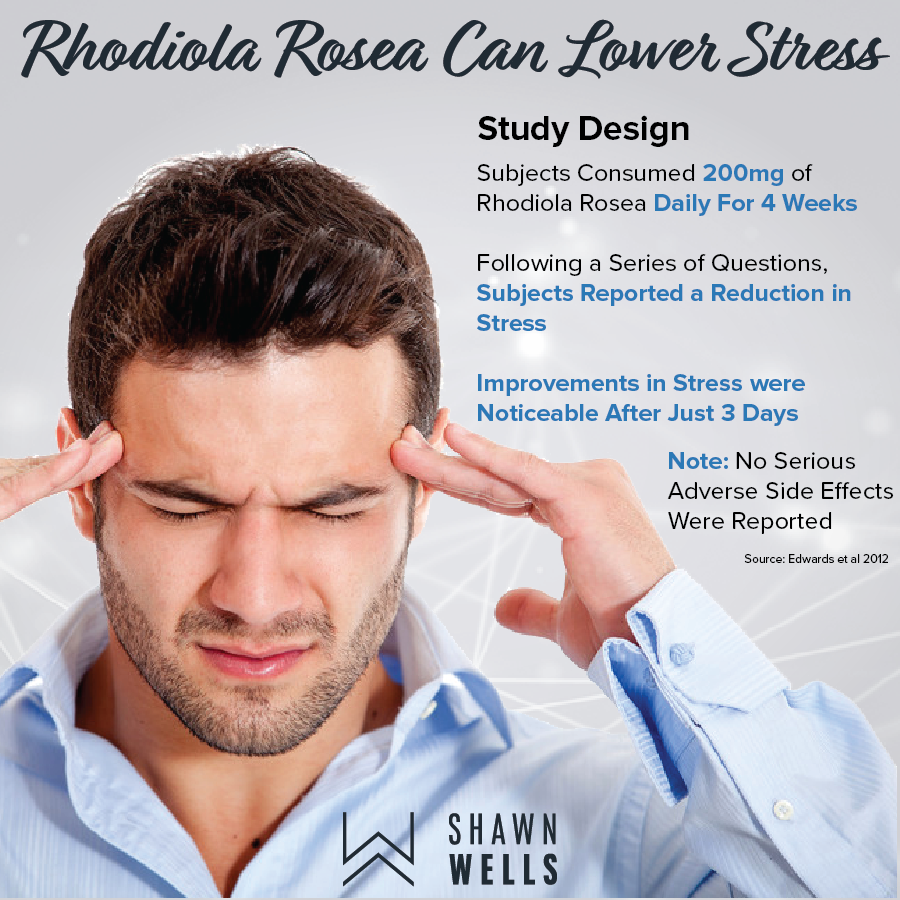
Rhodiola, also known as golden root, is used in Russia to combat fatigue, ward off sickness, and improve mood. Rhodiola’s most popular applications include relieving fatigue and improving concentration, memory, and productivity.19 Several studies have shown that supplementation with Rhodiola can:
- Stimulate focus and cognitive function
- Calm emotions
- Enhance learning
- Reduce fatigue
- Improve sleep
- Reduce irritability
- Increase strength
- Increase quantity and quality of work
- Improve mental and physical performance
- Improve feelings of wellbeing
Overall, Rhodiola is considered “an excellent choice for individuals who are weighed down by stress and fatigue as a result of demanding intellectual work.”19 I recommend using a Rhodiola supplement containing 3% Rosavins and 1% Salidrosides (the “active” components of the adaptogen). Dosing is typically 288 – 680mg per day. I’ve also formulated with a 5% rosavins and 2% salidrosides product.
Exogenous ketones
Under normal circumstances, the brain and central nervous system (CNS) rely on glucose for fuel. However, during periods of prolonged fasting (a few days) or severe carbohydrate restriction (as is the case with a very-low-carbohydrate, high-fat ketogenic diet), the body’s carbohydrate reserves become depleted. And since the brain and CNS cannot use fat for fuel, the body is forced to turn to an “alternate” energy source: Ketones.
Ketones are molecules produced by the liver (via a process called ketogenesis) as a by-product of fat burning. Research now suggests that ketones may be the preferred fuel source for the brain, and ketones have been shown to have cognitive performance (e.g., better focus, less brain fog, fewer energy crashes), cognitive health (reduced risk of neurodegeneration, reduced inflammation), and cognitive recovery (recovery from traumatic brain injury) benefits. Ketones, particularly BHB, may help upregulate the production of brain-derived neurotrophic factor (BDNF), which essentially serves as fertilizer for cells of the brain and CNS.
Ketones are not only used by the brain, they can also fuel skeletal and cardiac muscle. From a performance standpoint, ketones can help fuel endurance performance, enhance metabolic flexibility, and increase the body’s utilization of fat for fuel. Recent studies have shown that combining the ketogenic diet with weight lifting results in comparable (and in some cases, better) improvements in strength, power, and body composition as the typical Western diet.30–32
Supplementing with exogenous ketones can help expedite the process of getting into ketosis, provide the benefits of elevated blood ketone levels, and accelerate keto-adaptation—with or without following a ketogenic diet.
Optimal dosing is 5-10g of BHB (not accounting for the mineral salts bound to the BHB – including that would 6.5-13g of BHB salts.
DHA
It’s no surprise to see omega-3 supplements—such as fish, krill, and algal oils—at the top of recommended supplement lists. After all, EPA and DHA are nutrition all-stars. They are well-known for supporting:
- Heart health2–4
- Brain health, cognitive function, and mood5–10
- Eye health and vision11–13
- Skin health14,15
- Immune function16
- Metabolic function17–19
- A healthy inflammatory response20
Recent research has shown that DHA and EPA may also have anti-aging properties.21–23 Several recent studies have even shown that these super fats can boost metabolic rate, increase calorie-burning lean body mass, and boost fat burning to boot.17
But here’s the deal. Most people tend to refer to the two omega-3 fats DHA and EPA as if they are one and the same, leading many to believe that they are interchangeable and provide similar health benefits. The fact of the matter is that this couldn’t be further from the truth. You see, DHA and EPA each have very specific functions, and along those lines, offer very unique and distinct health benefits.
For instance, EPA levels seem to be closely correlated to mood, and studies have shown that supplementation with EPA can help boost feelings of wellbeing and help temper aggression.28,29 On the other hand, DHA generally exceeds EPA by 5- to 30-fold in most tissues of the body.30
In fact, DHA is the most predominant fatty acid in the brain and eye tissue, where it is several HUNDRED-fold more abundant than EPA. Along those lines, DHA has been shown to improve both memory and reaction time.9 DHA has also been found to elevate levels of brain-derived neurotrophic factor (BDNF), a very important growth factor for the brain and central nervous system that plays a key role in cognitive function, mood, and mental health.31
DHA may also be more effective than EPA at improving markers of heart health, and recent research shows that DHA appears to be superior to EPA when it comes to promoting a healthy inflammatory response.20,32,33 One particularly nifty attribute of DHA is that the body can convert it, on an as-needed basis, to EPA. However, the opposite is NOT true, meaning that the body can’t convert EPA to DHA.30
Based on the current body of research, a good recommendation is to take at least 500 – 1000mg (possibly as high as 2000mg) of DHA daily, and it’s a good idea to complement that with regular consumption of oily fish (e.g., wild salmon, sardines, mackerel, anchovies, oysters, mussels).
Probiotics and Prebiotics
Like omega-3 supplements, probiotics are commonly recommended and for many good reasons. Of course, probiotics are particularly popular due to their ability to help keep harmful microorganisms in check, promote a healthy balance of gut bacteria, support a healthy digestive tract, and aid in digestion and nutrient absorption.
Beyond that, there are several overlooked health benefits of probiotics including:
- Boosting immune function and supporting a healthy inflammatory response
- Enhancing intestinal barrier function
- Enhancing antimicrobial activity
- Staving off upper respiratory tract infections
- Boosting mood
- Reducing anxiety and helping manage the body’s stress response
- Improving cognitive function and memory
- Helping with weight management
- Increasing satiety and aiding with appetite control
- Enhancing sports performance
- Reducing muscle damage and enhancing recovery
- Promoting heart health
- Supporting healthy blood pressure and cholesterol levels
- Improving skin health and protecting the skin from photoaging
- Supporting detoxification
In addition to probiotics, prebiotics are also one of my top supplements. These indigestible carbohydrates essentially serve as “food” for the healthy bacteria in the gut, which ferment these fibers. A by-product of the fermentation is short-chain fatty acids such as butyrate, which fuels the immune system, signals the release of key appetite-suppressing hormones, and protects the brain and nervous system (via BDNF).
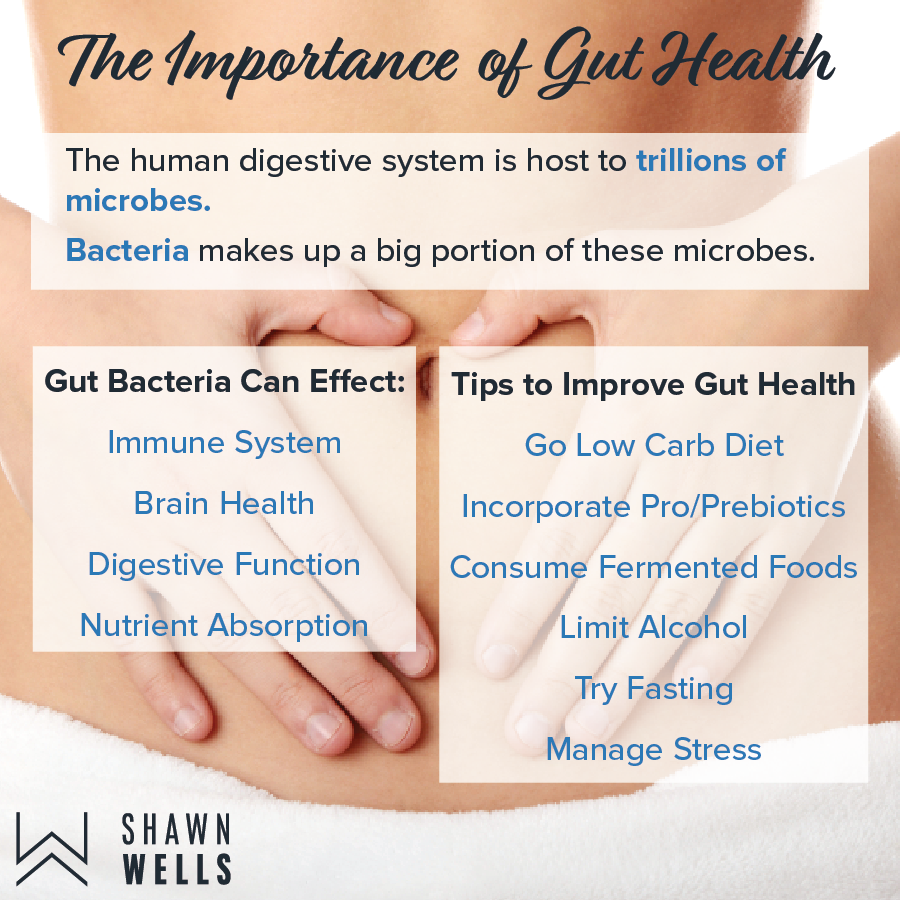
While it’s so difficult to narrow it down, there you have my top 10 supplements. There are so many others that I’ve used—and even currently use—and recommend to others. Along those lines, I’d love to hear your feedback, and if you have questions about supplements that didn’t make the list, please let me know.
References:
- Kreider RB, Kalman DS, Antonio J, et al. International Society of Sports Nutrition position stand: safety and efficacy of creatine supplementation in exercise, sport, and medicine. J Int Soc Sports Nutr. 2017;14:18. doi:10.1186/s12970-017-0173-z.
- De Jesus Moreno Moreno M. Cognitive improvement in mild to moderate Alzheimer’s dementia after treatment with the acetylcholine precursor choline alfoscerate: a multicenter, double-blind, randomized, placebo-controlled trial. Clin Ther. 2003;25(1):178-193.
- Bellar D, LeBlanc NR, Campbell B. The effect of 6 days of alpha glycerylphosphorylcholine on isometric strength. J Int Soc Sports Nutr. 2015;12:42. doi:10.1186/s12970-015-0103-x.
- Ziegenfuss TN, Habowski SM, Sandrock JE, Kedia AW, Kerksick CM, Lopez HL. A Two-Part Approach to Examine the Effects of Theacrine (TeaCrine®) Supplementation on Oxygen Consumption, Hemodynamic Responses, and Subjective Measures of Cognitive and Psychometric Parameters. J Diet Suppl. May 2016:1-15. doi:10.1080/19390211.2016.1178678.
- Taylor L, Mumford P, Roberts M, et al. Safety of TeaCrine®, a non-habituating, naturally-occurring purine alkaloid over eight weeks of continuous use. J Int Soc Sports Nutr. 2016;13:2. doi:10.1186/s12970-016-0113-3.
- Kuhman DJ, Joyner KJ, Bloomer RJ. Cognitive Performance and Mood Following Ingestion of a Theacrine-Containing Dietary Supplement, Caffeine, or Placebo by Young Men and Women. Nutrients. 2015;7(11):9618-9632. doi:10.3390/nu7115484.
- Aggarwal BB, Sung B. Pharmacological basis for the role of curcumin in chronic diseases: an age-old spice with modern targets. Trends Pharmacol Sci. 2009;30(2):85-94. doi:10.1016/j.tips.2008.11.002.
- Aggarwal BB, Sundaram C, Malani N, Ichikawa H. Curcumin: the Indian solid gold. Adv Exp Med Biol. 2007;595:1-75. doi:10.1007/978-0-387-46401-5_1.
- Jäger R, Lowery RP, Calvanese AV, Joy JM, Purpura M, Wilson JM. Comparative absorption of curcumin formulations. Nutr J. 2014;13:11. doi:10.1186/1475-2891-13-11.
- Wei W, Zhao H, Wang A, et al. A clinical study on the short-term effect of berberine in comparison to metformin on the metabolic characteristics of women with polycystic ovary syndrome. Eur J Endocrinol. 2012;166(1):99-105. doi:10.1530/EJE-11-0616.
- Yin J, Xing H, Ye J. Efficacy of berberine in patients with type 2 diabetes mellitus. Metabolism. 2008;57(5):712-717. doi:10.1016/j.metabol.2008.01.013.
- Wall CE, Yu RT, Atkins AR, Downes M, Evans RM. Nuclear Receptors and AMPK: Can Exercise Mimetics Cure Diabetes? J Mol Endocrinol. 2016;57(1):R49-R58. doi:10.1530/JME-16-0073.
- Chandrasekhar K, Kapoor J, Anishetty S. A Prospective, Randomized Double-Blind, Placebo-Controlled Study of Safety and Efficacy of a High-Concentration Full-Spectrum Extract of Ashwagandha Root in Reducing Stress and Anxiety in Adults. Indian J Psychol Med. 2012;34(3):255-262. doi:10.4103/0253-7176.106022.
- Singh N, Bhalla M, de Jager P, Gilca M. An Overview on Ashwagandha: A Rasayana (Rejuvenator) of Ayurveda. Afr J Tradit Complement Altern Med. 2011;8(5 Suppl):208-213. doi:10.4314/ajtcam.v8i5S.9.
- Wankhede S, Langade D, Joshi K, Sinha SR, Bhattacharyya S. Examining the effect of Withania somnifera supplementation on muscle strength and recovery: a randomized controlled trial. J Int Soc Sports Nutr. 2015;12. doi:10.1186/s12970-015-0104-9.
- Auddy B, Hazra J, Mitra A, Abedon B, Ghosal S. A Standardized Withania Somnifera Extract Significantly Reduces Stress-Related Parameters in Chronically Stressed Humans: A Double-Blind, Randomized, Placebo-Controlled Study. JANA. 2008;11(1):50-56.
- Picard M, Juster R-P, McEwen BS. Mitochondrial allostatic load puts the “gluc” back in glucocorticoids. Nat Rev Endocrinol. 2014;10(5):303-310. doi:10.1038/nrendo.2014.22.
- Seely D, Singh R. Adaptogenic Potential of a Polyherbal Natural Health Product: Report on a Longitudinal Clinical Trial. Evid-Based Complement Altern Med ECAM. 2007;4(3):375-380. doi:10.1093/ecam/nel101.
- Abascal K, Yarnell E. Increasing Vitality with Adaptogens: Multifaceted Herbs for Treating Physical and Mental Stress. Altern Complement Ther. 2003;9(2):54-60. doi:10.1089/107628003321536959.
- McCleary SA, Sharp MH, Lowery RP, et al. Effects of a ketogenic diet on strength and power. J Int Soc Sports Nutr. 2014;11(1):P41. doi:10.1186/1550-2783-11-S1-P41.
- Rauch JT, Silva JE, Lowery RP, et al. The effects of ketogenic dieting on skeletal muscle and fat mass. J Int Soc Sports Nutr. 2014;11(1):P40. doi:10.1186/1550-2783-11-S1-P40.
- Wilson JM, Lowery RP, Roberts MD, et al. The Effects of Ketogenic Dieting on Body Composition, Strength, Power, and Hormonal Profiles in Resistance Training Males. J Strength Cond Res. April 2017. doi:10.1519/JSC.0000000000001935.
- Kris-Etherton PM, Harris WS, Appel LJ. Fish Consumption, Fish Oil, Omega-3 Fatty Acids, and Cardiovascular Disease. Circulation. 2002;106(21):2747-2757. doi:10.1161/01.CIR.0000038493.65177.94.
- Bradberry JC, Hilleman DE. Overview of Omega-3 Fatty Acid Therapies. Pharm Ther. 2013;38(11):681-691.
- Lee JH, O’Keefe JH, Lavie CJ, Marchioli R, Harris WS. Omega-3 fatty acids for cardioprotection. Mayo Clin Proc. 2008;83(3):324-332. doi:10.4065/83.3.324.
- Morris MC, Evans DA, Bienias JL, et al. Consumption of fish and n-3 fatty acids and risk of incident Alzheimer disease. Arch Neurol. 2003;60(7):940-946. doi:10.1001/archneur.60.7.940.
- Hibbeln JR, Ferguson TA, Blasbalg TL. Omega-3 fatty acid deficiencies in neurodevelopment, aggression and autonomic dysregulation: opportunities for intervention. Int Rev Psychiatry Abingdon Engl. 2006;18(2):107-118. doi:10.1080/09540260600582967.
- Parker G, Gibson NA, Brotchie H, Heruc G, Rees A-M, Hadzi-Pavlovic D. Omega-3 fatty acids and mood disorders. Am J Psychiatry. 2006;163(6):969-978. doi:10.1176/appi.ajp.163.6.969.
- Osher Y, Belmaker RH. Omega-3 fatty acids in depression: a review of three studies. CNS Neurosci Ther. 2009;15(2):128-133.
- Stonehouse W, Conlon CA, Podd J, et al. DHA supplementation improved both memory and reaction time in healthy young adults: a randomized controlled trial. Am J Clin Nutr. 2013;97(5):1134-1143. doi:10.3945/ajcn.112.053371.
- Witte AV, Kerti L, Hermannstädter HM, et al. Long-chain omega-3 fatty acids improve brain function and structure in older adults. Cereb Cortex N Y N 1991. 2014;24(11):3059-3068. doi:10.1093/cercor/bht163.
- SanGiovanni JP, Chew EY. The role of omega-3 long-chain polyunsaturated fatty acids in health and disease of the retina. Prog Retin Eye Res. 2005;24(1):87-138. doi:10.1016/j.preteyeres.2004.06.002.
- Stough C, Downey L, Silber B, et al. The effects of 90-day supplementation with the omega-3 essential fatty acid docosahexaenoic acid (DHA) on cognitive function and visual acuity in a healthy aging population. Neurobiol Aging. 2012;33(4):824.e1-3. doi:10.1016/j.neurobiolaging.2011.03.019.
- McCusker MM, Durrani K, Payette MJ, Suchecki J. An eye on nutrition: The role of vitamins, essential fatty acids, and antioxidants in age-related macular degeneration, dry eye syndrome, and cataract. Clin Dermatol. 2016;34(2):276-285. doi:10.1016/j.clindermatol.2015.11.009.
- Cosgrove MC, Franco OH, Granger SP, Murray PG, Mayes AE. Dietary nutrient intakes and skin-aging appearance among middle-aged American women. Am J Clin Nutr. 2007;86(4):1225-1231.
- Schagen SK, Zampeli VA, Makrantonaki E, Zouboulis CC. Discovering the link between nutrition and skin aging. Dermatoendocrinol. 2012;4(3):298-307. doi:10.4161/derm.22876.
- Gurzell EA, Teague H, Harris M, Clinthorne J, Shaikh SR, Fenton JI. DHA-enriched fish oil targets B cell lipid microdomains and enhances ex vivo and in vivo B cell function. J Leukoc Biol. 2013;93(4):463-470. doi:10.1189/jlb.0812394.
- Logan SL, Spriet LL. Omega-3 Fatty Acid Supplementation for 12 Weeks Increases Resting and Exercise Metabolic Rate in Healthy Community-Dwelling Older Females. PLOS ONE. 2015;10(12):e0144828. doi:10.1371/journal.pone.0144828.
- Abbott KA, Burrows TL, Thota RN, Acharya S, Garg ML. Do ω-3 PUFAs affect insulin resistance in a sex-specific manner? A systematic review and meta-analysis of randomized controlled trials. Am J Clin Nutr. 2016;104(5):1470-1484. doi:10.3945/ajcn.116.138172.
- Jeromson S, Gallagher I, Galloway S, Hamilton D. Omega-3 Fatty Acids and Skeletal Muscle Health. Mar Drugs. 2015;13(12):6977-7004. doi:10.3390/md13116977.
- Allaire J, Couture P, Charest A, et al. DHA is more potent than EPA in attenuating cardiometabolic risk in men and women: a randomized double-blind, placebo-controlled crossover trial. FASEB J. 2016;30(1 Supplement):130.1-130.1.
- Kiecolt-Glaser JK, Epel ES, Belury MA, et al. Omega-3 fatty acids, oxidative stress, and leukocyte telomere length: A randomized controlled trial. Brain Behav Immun. 2013;28:16-24. doi:10.1016/j.bbi.2012.09.004.
- Farzaneh-Far R, Lin J, Epel ES, Harris WS, Blackburn EH, Whooley MA. Association of marine omega-3 fatty acid levels with telomeric aging in patients with coronary heart disease. JAMA. 2010;303(3):250-257. doi:10.1001/jama.2009.2008.
- Farzaneh-Far R, Lin J, Epel E, Lapham K, Blackburn E, Whooley MA. Telomere length trajectory and its determinants in persons with coronary artery disease: longitudinal findings from the heart and soul study. PloS One. 2010;5(1):e8612. doi:10.1371/journal.pone.0008612.
- Martins JG. EPA but not DHA appears to be responsible for the efficacy of omega-3 long chain polyunsaturated fatty acid supplementation in depression: evidence from a meta-analysis of randomized controlled trials. J Am Coll Nutr. 2009;28(5):525-542.
- Logan AC. Omega-3 fatty acids and major depression: a primer for the mental health professional. Lipids Health Dis. 2004;3:25. doi:10.1186/1476-511X-3-25.
- Arterburn LM, Hall EB, Oken H. Distribution, interconversion, and dose response of n-3 fatty acids in humans. Am J Clin Nutr. 2006;83(6 Suppl):1467S-1476S.
- Matsuoka Y, Nishi D, Yonemoto N, Hamazaki K, Hamazaki T, Hashimoto K. Potential Role of Brain-Derived Neurotrophic Factor in Omega–3 Fatty Acid Supplementation to Prevent Posttraumatic Distress after Accidental Injury: An Open-Label Pilot Study. Psychother Psychosom. 2011;80(5):310-312. doi:10.1159/000322980.
- Buckley R, Shewring B, Turner R, Yaqoob P, Minihane AM. Circulating triacylglycerol and apoE levels in response to EPA and docosahexaenoic acid supplementation in adult human subjects. Br J Nutr. 2004;92(3):477-483.
- Jacobson TA, Glickstein SB, Rowe JD, Soni PN. Effects of eicosapentaenoic acid and docosahexaenoic acid on low-density lipoprotein cholesterol and other lipids: a review. J Clin Lipidol. 2012;6(1):5-18. doi:10.1016/j.jacl.2011.10.018.